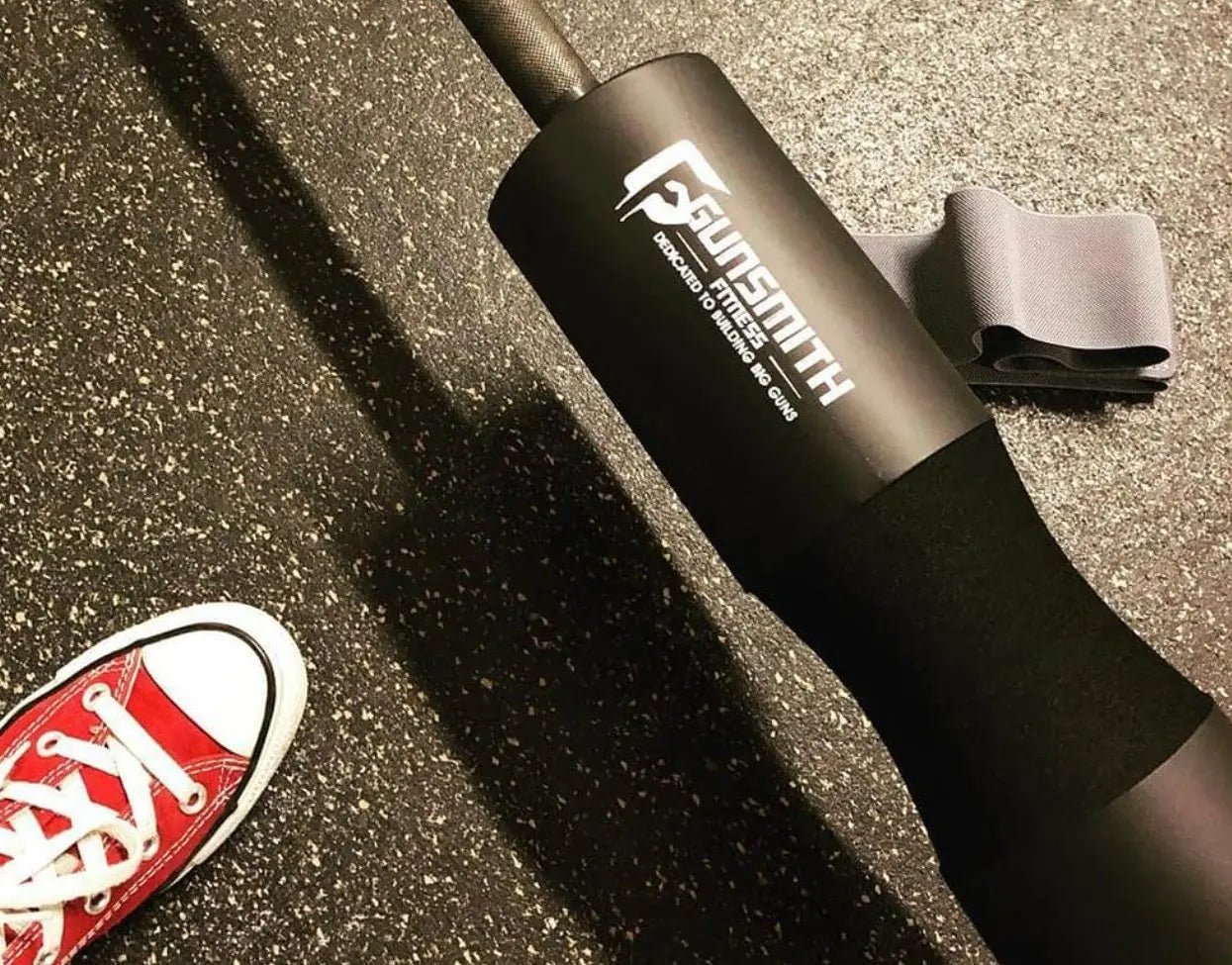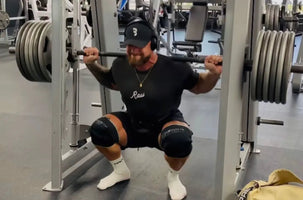
Glute Bridge vs Hip Thrust: Which is More Effective for Building Glutes?
Wondering if it's time to incorporate bridges and hip thrusts into your workout routine and glute training? Both are two of the most effective exercises for developing the gluteal muscles. These exercises target the same muscle group, but they differ in terms of equipment, setup, and execution. In this article, we will explore the differences between glute bridge vs hip thrust, how to perform them, and their benefits and effectiveness.
Let's dive into the differences between these two exercises to understand what they are. The glute bridge is effective in targeting the glutes and hamstrings plus the lower back. It involves lying on your back with your knees bent and feet flat on the ground, then lifting your hips off the ground until your body forms a straight line from your shoulders to your knees. On the other hand, the hip variation is a weighted exercise that targets the same muscle group. Hip thrusts are performed by sitting on the ground with your back against a bench, then lifting a barbell or weight plate using your hips.
The main difference between the two exercises is the setup and the amount of weight used. Glute bridges are done with your upper back and shoulders on the ground, while hip thrusts start from a seated position with the shoulders elevated on a bench. Additionally, the latter allows you to add more weight than the former, which can lead to greater glute and hammy gains.
Understanding Glute Bridge and Hip Thrust
Glute Bridge
A bodyweight exercise that involves lying on your back with your knees bent and feet flat on the ground. From this position, you lift your hips up towards the ceiling by squeezing your glutes and pushing through your heels. The movement should be slow and controlled, with a focus on engaging the glutes and maintaining a neutral spine.
They are a great exercise for beginners because they are low-impact and easy to perform. They can also be modified to make them more challenging, such as by adding resistance bands or holding a weight on your hips.

Hip Thrust
This is a loaded glute bridge exercise that involves using a barbell or other weight to add resistance to the movement. To perform the hip thrust exercise, you sit on the ground with your back against a bench and place a barbell across your hips. From this position, you drive your hips up towards the ceiling, squeezing your glutes at the top of the movement.
These are a more advanced exercise than glute bridges and require access to a gym or weightlifting equipment. They are also more effective for building strength and power in the glutes, as they allow you to add more resistance to the movement.

Which Exercise Is Better?
Both the glute bridge and the hip thrust are exercises that have their benefits, and the choice between them depends on your fitness goals and preferences. The glute variation is a great exercise for beginners or those who prefer bodyweight exercises, while hip thrusts are better for advanced lifters or those looking to add more resistance to their workouts.
It's also worth noting that both exercises can be included in a well-rounded lower body workout routine. By combining both with other exercises like squats and lunges, you can treat poor hip mobility target all the major muscle groups in your lower body for a more complete workout.
Basic Anatomy and Muscles Involved
It's important to first understand the basic anatomy and muscles involved in these exercises. Both exercises primarily hit the glutes, which are a group of three muscles located in the buttocks: the gluteus maximus, gluteus minimus, and gluteus medius.
The gluteus maximus is the largest muscle in the glutes and is responsible for hip extension, which is the movement of the thigh backward. The gluteus minimus and medius are smaller muscles located on the outer surface of the pelvis and are responsible for hip abduction, which is the movement of the thigh away from the midline of the body.
In addition to the glutes, both exercises also involve the hamstrings, which are a group of three muscles located on the back of the thigh. These are responsible for knee flexion and hip extension.
Both exercises also engage the core muscles, which are the muscles that stabilize the spine and pelvis during movement. The core muscles include the rectus abdominis, obliques, transverse abdominis, and erector spinae.
While both exercises target the same muscle groups, they differ in terms of muscle activation and growth. The hip thrust is generally considered to be a more advanced exercise that allows for greater glute and hamstring activation and potential muscle growth due to the ability to add more weight.

Difference between a Glute Bridge vs Hip Thrust
What's the difference? While both exercises are effective in building glute strength and size, there are some key differences between the two.
Differences
The table below summarizes the key differences between the the two exercises:
| Glute Bridge | Hip Thrust |
|---|---|
| Bodyweight exercise | Requires a bench and weighted object |
| Beginner-friendly | More advanced exercise |
| Engages other muscles, such as abs and hamstrings | More targeted exercise for glutes |
| Limited resistance | Allows for more weight and resistance to be added |
While both are effective exercises for building glute strength and size, they differ in terms of equipment required, level of difficulty, and muscle activation. The choice between the two exercises ultimately depends on individual goals, fitness level, and available equipment.
Bodyweight & Barbell Glute Bridge / Hip Bridge
When it comes to equipment and setup, both exercises activates the glutes and hamstrings, they can be done with body weight alone, but adding resistance can increase the difficulty and effectiveness of the exercise. When performing both exercises, proper form is essential to ensure maximum benefit and avoid injury. Both require the individual to lie on their back with their knees bent and feet firmly placed on the ground.
Glute Bridge
The glute bridge is performed with just a mat or yoga mat. However, adding a resistance band or dumbbells can increase the difficulty of the exercise. For the glute bridge, the individual lifts their hips off the ground until their body forms a straight line from their shoulders to their knees. They then lower their hips back down to the ground. It is important to maintain a neutral spine and engage the core throughout the movement. To perform the glute bridge:
- Lie on your back with your knees bent and feet flat on the floor.
- Place your arms at your sides with your palms facing down.
- Push your hips up toward the ceiling, squeezing your glutes at the top.
- Lower your hips back down to the ground and repeat.
Hip Thrust
This requires a bench or box for back support. You can also use a workout bench or a step. Adding a barbell, dumbbells, or plates can increase the difficulty and effectiveness of the exercise, obviously the weight of the plates increase the intensity of the glute workout. Many find that rolling up a mat, towel or using a pad helps alleviate the pressure from the bar.
The hip thrust starts in a seated position with the shoulders elevated on a bench or box. The individual then lifts their hips until their body forms a straight line from their shoulders to their knees. They then lower their hips back down to the starting position. It is important to maintain proper posture and engage the core throughout the movement.To perform:
- Sit on the ground with your back against the bench or box.
- Roll a barbell across your hips. It can also be done without a barbell
- Place your feet flat on the ground with your knees bent.
- Grip the barbell, add and lift weight, push your hips toward the ceiling, perform the barbell hip thrust making sure to squeeze at the top.
- Lower your hips back down to the ground and repeat.

When performing either exercise, it is important to keep the knees in line with the feet and avoid letting them collapse inward. The individual should also focus on driving through their heels to engage the glutes and avoid putting unnecessary strain on the knees.
When adding weight, it is important to maintain proper form and avoid arching the lower back. The individual should also focus on a full range of motion, lowering the hips until they are just above the ground before lifting them back up to a 90-degree angle.
Overall, both the glute bridge and hip thrust are effective exercises for targeting the glutes and lower body. Proper form, posture, and mobility are essential to ensure maximum benefit and avoid injury.
Other Glute Exercises
There are several other exercises that can help strengthen and tone the glutes. Here are a few examples:
Squats
Squats are a compound exercise that work multiple muscle groups, including the glutes. They can be performed with bodyweight or with added weight, such as a barbell or dumbbells. Squats can be done in several variations, including back squats, front squats, and sumo squats.
Lunges
Lunges are another compound exercise that primarily targets the glutes, as well as the quads and hamstrings. They can be done with bodyweight or with added weight, such as dumbbells or a barbell. Lunges can be performed in several variations, including walking lunges, reverse lunges, and side lunges.
Deadlifts
Deadlifts are a compound exercise that primarily work the hamstrings and lower back, but also engage the glutes. They can be done with a barbell or dumbbells, and come in several variations, including conventional deadlifts, sumo deadlifts, and Romanian deadlifts.
Step-Ups
Step-ups are a unilateral exercise that work one leg at a time, which can help correct muscle imbalances. They can be done with a bench or step, and can be performed with bodyweight or with added weight, such as dumbbells or a barbell.
Glute Kickbacks
Glute kickbacks are an isolation exercise that target the gluteus maximus. They can be done with bodyweight or with added weight, such as resistance bands, ankle weights or a cable machine. Glute kickbacks can be performed in several variations, including standing, kneeling, and lying down.
Overall, incorporating a variety of exercises into a workout routine can help target the glutes from different angles and promote overall strength and tone.

Special Variations
There are several special variations that can help target specific areas and muscles. They are all done in the start position of lying on your back with your knees bent and feet flat on the ground. Here are some variations to consider:
Single-Leg Glute Bridge
The single-leg variation of the glute bridge that involves lifting one leg off the ground while performing the exercise. This variation helps to increase glute strength and activation, as well as improve balance. Lift one leg off the ground and extend it straight out in front of you. Then, lift your hips up off the ground, squeezing your glutes at the top of the movement. Lower your hips back down to the ground and repeat on the other leg.
Banded Glute Bridge
The banded variation of the glute bridge that involves placing a resistance band around your thighs. This helps to increase glute activation and strength, as well as challenge your balance. Place a resistance band around your thighs, just above your knees. Then, lift your hips up off the ground, squeezing your glutes at the top of the movement. Lower your hips back down to the ground and repeat.
Yoga Bridge
The yoga bridge is a variation that is commonly used in yoga practice. This exercise helps to improve glute activation and strength, as well as stretch the shins and quads. Place your hands on the ground beside your hips, palms facing down. Then, lift your hips up off the ground, squeezing your glutes at the top of the movement. Hold for a few breaths, then lower your hips back down to the ground.
Hands-Free Hip Thrust
The hands-free hip thrust is a variation that involves keeping your hands off the ground. This helps to increase glute activation and strength, as well as challenge your balance. Lean back slightly and lift your hips up off the ground, squeezing your glutes at the top of the movement. Hold for a few seconds, then lower your hips back down to the ground.
Benefits and Effectiveness
Both are effective exercises for building strength and activating the glutes, but each exercise has unique benefits.
In terms of effectiveness, both exercises target the glutes, but the focus shifts slightly with each exercise. The glute bridge targets the lower glutes, while the hip thrust targets the upper glutes. Therefore, incorporating both exercises into a workout routine can lead to some serious glute gains
Precautions and Potential Injuries
When performing it is important to take certain precautions to avoid injury. The following are some potential injuries that can occur and how to prevent them:
Warm-up
Before starting any exercise, it is important to warm up properly. This can help prevent injury and ensure that the muscles are ready for the workout. A good warm-up can include light cardio, dynamic stretches, and foam rolling.
Hip Flexors
Hip flexors and hip abductors can become tight and cause discomfort during glute bridges and hip thrusts. It is important to stretch the hip flexors before and after the workout. A good stretch is the kneeling hip flexor stretch.
Back Pain
If not done properly, glute bridges and hip thrusts can cause back pain. It is important to keep the back straight and engage the core muscles. A cushion or yoga mat can also be used for extra support.
Strain
Overexertion can cause strain in the glutes, hamstrings, and lower back. It is important to start with lighter weights and gradually increase the weight as strength improves. A personal trainer can also provide guidance on proper form and weight progression.
It is important to take certain precautions to avoid injury. Warming up properly, stretching the hip flexors, keeping the back straight, and starting with lighter weights are all important steps to prevent injury.
Frequently Asked Questions
What are the benefits of doing hip thrusts?
Both exercises help to improve hip extension, which can enhance athletic performance and reduce the risk of injury. Additionally, they can help to improve posture and alleviate lower back pain.
What muscles do glute bridges work?
Bridges primarily work the gluteus maximus, which is the largest muscle in the buttocks. They also engage the hamstrings, core, and lower back muscles to a lesser extent.
What is the difference between a glute bridge and a hip thrust?
The main differences between the glute bridge and a hip thrust is the starting position. In the former, the upper back and shoulders are on the ground, while in a hip variation, the shoulders are elevated on a bench. This difference in position changes the angle of the movement and can impact the muscles that are targeted.
Can glute bridges be a substitute for hip thrusts?
Whilst both target the glutes, they are not exact substitutes for each other. Thrusts tend to be more effective at building glute strength and power, while bridges are a more beginner-friendly exercise that can help to activate the glutes, abs, and hamstrings.
What is the proper form for doing a hip thrust?
Sit on a bench with your knees and feet firmly on the ground. Rest your shoulder blades, but not your neck, against the bench. If required, use a barbell to your hip crease. Proceed to contract your glutes and core muscles, and gradually raise your hips until your back is parallel to the ground. Adding a foam pad to the barbell can make the exercise more comfortable.
Are hip thrusts or squats better for building glute muscles?
Both can be effective for building glute muscles, but they target the muscles in slightly different ways. Squats engage the quads, hamstrings, and glutes, while thrusts place more emphasis on the glutes. Incorporating both exercises into a workout routine can help to maximize glute development.
Related Posts
- 5 Fantastic Hip Circle Exercises to Increase Mobility & Get Loose
- 4 Reasons Every Athlete Should Incorporate Hip Circles Into Their Training
- Hip Circles 101: Everything You Need to Know About This Unique Training Device
- 11 Excellent Exercise Band Training Tips and Tricks
- What Are Mobility Bands Or Hip Circles Good For?
- Grow Those Glutes! The Best Exercises for Growing a Bigger Butt
- Hip Thrust 101 - Everything You Need to Know About Hip Thrusts/Glute Bridges





